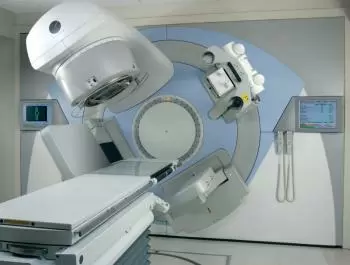
Radiotherapy is the specialty of nuclear medicine that uses ionizing radiation to treat malignant tumors.
When non-encapsulated radioactive sources are used, it is called metabolic radiotherapy.
This technique involves injecting or ingesting a relatively large dose of a radioactive substance in liquid form. This substance accumulates in the organ to be treated and emits radiation to the tissues in contact with it. In this way, the radiation emitted destroys tumor cells.
What is radiotherapy?
Radiation therapy is a medical treatment that uses x-rays or other high-powered particles to destroy cancer cells. Unlike chemotherapy, radiation therapy cannot be used to treat all types of cancer.
This type of radiation treatment can be given in several ways:
-
External radiation therapy: The radiation source is outside the body.
-
Internal radiation therapy: The radiation source is inside the body.
Use and applications in medical treatments
Radiotherapy is a medical treatment that destroys cancer cells. It is often used along with other treatments, such as chemotherapy and surgery.
Radiation therapy can be used to treat patients with cancer of the lung, breast, prostate, head and neck, uterus, ovaries, testicles, hyperthyroidism, thyroid cancer, bone metastases from prostate tumors, and brain tumors. Radiation therapy may also be used to relieve pain caused by cancer.
In the case of thyroid cancer, iodine-131 is used, which is a gamma emitter. In this case, the patient is admitted to special units that have radioprotection units and care from specialized medical personnel.
Once the patient has been discharged, a dosimetric control is carried out periodically to monitor and verify that, due to its low doses of gamma radiation, the patient can live with his family and the rest of the population.
Examples of treatments
Applications of radiotherapy include teletherapy and brachytherapy.
Teletherapy
Teletherapy is a radiotherapy nuclear medicine technique in which the radioactive source is not in direct contact with the tumor being treated.
Among the gamma emitting sources used, the encapsulated cobalt-60 source stands out, contained in the so-called cobalt bomb, which prevents the radiation from escaping except through a hole that provides directed radiation.
Teletherapy produces high-energy radiation (1.2 MeV) capable of irradiating large, deeply located tumors. Teletherapy can also be administered with electronic and neutron beam emitting sources.
Objective of treatment through teletherapy
There are different nuclear medicine treatments through teletherapy focused on achieving different objectives:
-
Radical or curative treatment: In radical therapy, the purpose of treatment is to destroy the tumor and cure the patient.
-
Palliative medical treatment: The purpose of palliative care is mainly to reduce the signs of the tumor induced by the disease (pain relief, tumor-related bleeding), even though we know that the disease is no longer curable. The essential purpose of palliative care is primarily to allow patients to live as long as possible and with a good quality of life, although the cancer cannot be destroyed.
-
Preoperative treatment: The purpose of preoperative irradiation is to irradiate with the goal of shrinking the tumor before the surgery itself.
Brachytherapy
Brachytherapy is a type of radiotherapy treatment in which the tumor receives radiation through direct contact with the radioactive source. This technique is also known by the name Curieterapia.
There are three brachytherapy treatment options:
-
Superficial brachytherapy: plates of radioactive material are placed over the tumor area.
-
Intracavitary brachytherapy: the radioactive source is temporarily introduced into the patient's natural cavities. For this technique, encapsulated sources of cesium-137 are usually used.
-
Interstitial brachytherapy: The radiotherapy technician places the radioactive sources in certain tissues of the patient.
One of the problems with this type of radiotherapy is the possible unnecessary exposure of the patient and healthcare personnel to radiation from the sources. To avoid this inconvenience, the source must be placed in the correct position in the patient receiving radiotherapy. To do this, healthcare personnel use remote control controls to prepare, transport and manipulate radioactive sources.
Side effects
Radiotherapy can cause side effects in the patient since it can eliminate healthy cells. Some of these effects are acute and transient, while others are delayed and persistent. Acute ones usually appear during treatment or immediately after, while late ones may not appear until months or years after treatment.
The side effects of radiation therapy depend on various factors, such as the dose administered, the area of the body irradiated, and the individual sensitivity of the patient.
Most side effects are mild and reversible, and disappear after treatment ends. However, some side effects can be serious and/or irreversible.
Radioprotectors are currently being studied to protect normal cells in healthy tissues that may be affected by treatment.
It is important to talk to your doctor about possible side effects before starting treatment.